JUNE KEY FIGURES
 |  | Mar Qtr 2004 | Jun Qtr 2004 | Mar Qtr 2004 to Jun Qtr 2004 |
 |  | $m | $m | % change |
TREND ESTIMATES |
|
| Balance on current account | -12,029 | -12,087 | 0 |
| Balance on goods and services | -6,049 | -6,043 | 0 |
| Net income | -5,956 | -6,031 | -1 |
SEASONALLY ADJUSTED |
|
| Balance on current account | -12,089 | -11,967 | 1 |
| Balance on goods and services | -6,315 | -5,974 | 5 |
| Net income | -5,738 | -6,019 | -5 |
ORIGINAL |
|
| Balance on current account | -10,293 | -12,016 | -17 |
| Balance on capital and financial account | 10,667 | 12,047 | 13 |
Levels at end of period |
|
| Net international investment position (IIP) | 489,304 | 501,146 | 2 |
 | Net equity | 113,594 | 107,656 | -5 |
 | Net debt | 375,709 | 393,489 | 5 |
|
Current Account, Main aggregates -
Trend estimates at current prices
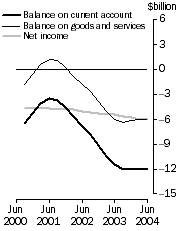
| International Investment,
Levels at end of period
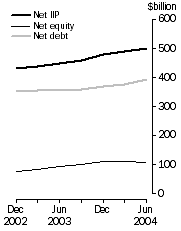
|
JUNE KEY POINTS
BALANCE OF PAYMENTS
- The current account deficit, seasonally adjusted, fell $122m to $11,967m. The deficit on the balance of goods and services fell $341m to $5,974m. The income deficit rose $281m to $6,019m.
- In seasonally adjusted chain volume terms there was an increase of $264m (2%) in the deficit on goods and services. This could be expected to contribute -0.1 percentage points to growth in the June quarter 2004 volume measures of GDP.
- In original terms, the balance on current account for 2003-04 was a deficit of $47.4b, up $7.1b from the deficit of $40.3b in 2002-03.
INTERNATIONAL INVESTMENT POSITION
- Australia's net IIP rose $12b to a net liability of $501b. Net foreign debt was $393b, an increase of $18b, mostly due to net debt inflows of $13b and exchange rate changes of $10b, consistent with the depreciation of the Australian dollar. Offsetting these increases were falls in price changes and other changes totalling $6b. Net equity liabilities fell $6b to $108b.
NOTES
CHANGES IN THIS ISSUE
Revisions
Table 34 summarises revisions, in original current price terms, since the last issue of this publication, for the last three years and six quarters.
Incorporation of the latest survey and administrative data has resulted in revisions to the current account back to September quarter 2000, decreasing the 2002-03 current account deficit by $1,206m. The financial account and international investment position have been revised back to September quarter 2000, increasing Australia's net IIP liability as at 30 June 2003 by $9,639m. Details of the revisions to the current and financial accounts from September quarter 2000 are provided on page 8.
Chain Volume Measures
Chain volume and associated price measures in this issue incorporate a new base year (2002-03) which has resulted in revisions to growth rates for the most recent financial years. The reference year has been advanced to 2002-03, resulting in revisions to levels for all periods.
ROUNDING
Discrepancies may occur between totals in this publication and the same aggregates from other sources, and between sums of component items and totals due to rounding.
CHANGES IN FORTHCOMING ISSUES
Seasonal Adjustment
The method of estimating seasonally adjusted and trend estimates of the current account and its components will change to concurrent seasonal adjustment from the next issue of this publication. An explanation and the implications of this change are provided on page 8 of this publication.
Table changes
Commencing with the September 2004 issue of this publication, an additional table covering the seasonally adjusted and trend estimates of services credits and debits will be included. The additional table will be inserted as Table 6, which will result in the existing table numbers (Tables 6 through to 37) in this publication and in the electronic release of this publication to be re-numbered as Tables 7 through to 38.
Additionally, the new Table 6 will contain two new memorandum items - estimates of Tourism related services credits and debits. These estimates will be derived by aggregating various tourism related service components compiled as part of the standard presentation.
INQUIRIES
For further information contact Tom Jebbink on (02) 6252 5540 for balance of payments estimates, and Sawbhag Naidu on (02) 6252 5541 for international investment estimates.
TABLES ON AUSSTATS
TABLES AVAILABLE ON AUSSTATS
Data available on the ABS web site <www.abs.gov.au> include:
- longer time series of all tables contained in this publication
- additional tables as listed below:
51 Balance of payments: summary, original - Financial year
52 International investment position by net foreign equity and net foreign debt - Financial year
53 International investment position by foreign assets and foreign liabilities - Financial year
56a Goods and services: chain volume measures, original - Financial year
56b Goods and services: implicit price deflators and chain laspeyres price indexes, original - Financial year
56c Goods and services: terms of trade, seasonally adjusted - Financial year
58 Goods credits: original - Financial year
59 Goods debits: original - Financial year
60 Goods credits: chain volume measures, original - Financial year
61 Goods debits: chain volume measures, original - Financial year
66 Goods credits: implicit price deflators (Index numbers) - Financial year
67 Goods debits: implicit price deflators (Index numbers) - Financial year
68 Services credits: original - Financial year
69 Services debits: original - Financial year
70a Services credits: current prices and chain volume measures, original - Financial year
70b Services credits: implicit price deflators (Index numbers) - Financial year
71a Services debits: current prices and chain volume measures, original - Financial year
71b Services debits: implicit price deflators (Index numbers) - Financial year
72 Income credits: original - Financial year
73 Income debits: original - Financial year
74 Current transfers: original - Financial year
75 Capital account - Financial year
76a International investment: direct investment transactions - Financial year
76b International investment: portfolio investment transactions - Financial year
77a International investment: other investment transactions, assets - Financial year
77b International investment: other investment transactions, liabilities - Financial year
77c International investment: reserve assets transactions - Financial year
77d International investment: financial derivatives transactions - Financial year
78 International investment: foreign assets by direction and type of investment - Financial year
79 International investment: foreign liabilities by direction and type of investment - Financial year
80 International investment: Australian investment abroad - Financial year
81 International investment: foreign investment in Australia - Financial year
82 International investment: levels of Australian investment abroad - Financial year
83 International investment: levels of foreign investment in Australia - Financial year
84 International investment: foreign debt transactions - Financial year
85 International investment: foreign debt levels at the end of period - Financial year
86 International investment: interest income on foreign debt - Financial year
87 International investment: currency and residual maturity of foreign debt - Financial year
88 Balance of payments: exchange rates - Financial year
89a International investment: foreign liabilities by industry - Financial year
89b International investment: foreign assets by industry - Financial year
90a Balance of payments: gross domestic product (GDP), original - Financial year
90b Balance of payments: ratios to GDP and goods and services credits, percentage change - Financial year
94 International investment position: historical summary - Financial year
95 Quarterly combined current price seasonal adjustment factors, September 1959 to September 2004
96 International investment: gross external debt liabilities: levels - Financial year
101 Merchandise exports by SITC division on a Balance of payments basis, chain volume measures
102 Merchandise exports by SITC division on a Balance of payments basis, implicit price deflators
103 Merchandise exports by SITC division and section on a Recorded trade basis, chain volume measures
104 Merchandise exports by SITC division and section on a Recorded trade basis, implicit price deflators
105 Merchandise imports by End-Use categories on a Balance of payments basis, chain volume measures
106 Merchandise imports by End-Use categories on a Balance of payments basis, implicit price deflators
107 Merchandise imports by SITC division and section on a Recorded trade basis, chain volume measures
108 Merchandise imports by SITC division and section on a Recorded trade basis, implicit price deflators
109 Services credits and debits, confidentialised version, chain volume measures
110 Services credits and debits, confidentialised version, implicit price deflators
CHANGES IN THIS AND FORTHCOMING ISSUES
REVISIONS FROM SEPTEMBER QUARTER 2000 TO MARCH QUARTER 2004
REVISIONS
The ABS's Survey of International Investment is designed to collect data for the compilation of Australia's International Investment Position and the related financial account of the Balance of Payments. The survey also collects income data which forms the basis of the investment income estimates included in the current account of the Balance of Payments.
A considerable amount of investigative work has been undertaken into the quality and accuracy of data from respondents to this survey which has resulted in an increase net IIP in all 15 quarters. By March quarter 2004, the cumulative effect of the revisions was to increase net IIP by $11.0b. Of this, net equity was $9.0b and net debt was $1.9b. There have also been significant revisions to the investment income component of the Balance of Payments.
The main revisions were due to the correction of overlaps in the activities of fund managers, the inclusion of kangaroo bonds where it was identified that there was under-coverage of this type of debt instrument, the identification of a number of inter-company loans and the replacement of estimated data with actual data from respondents.
A summary of the revisions to the Balance of Payments and International Investment Position is provided in Table 34 of this publication.
CONCURRENT SEASONAL ADJUSTMENT
INTRODUCTION
The ABS is in the process of introducing concurrent adjustment for all seasonally adjusted indicators. The ABS has previously outlined the advantages of concurrent seasonal adjustment methodology and implemented this method on several main ABS economic indicators. One such economic indicator containing a comparison analysis of concurrent seasonal adjustment is available on the ABS website - Information Paper: Introduction of Concurrent Seasonal Adjustment into the Retail Trade Series (cat. no. 8514.0) released in December 1999. Users' responses to these changes have been positive. A more detailed explanation of concurrent seasonal adjustment is available on the ABS website - Use of concurrent seasonal adjustment for economic time series: the case for Retail Survey (refer to the ABS Methodology Advisory Committee for June 2001 available from the ABS website).
The ABS will introduce concurrent seasonal adjustment into the quarterly Balance of Payments and International Investment Position (cat. no. 5302.0 ) publication from the September quarter 2004 issue.
EXPLANATION OF CONCURRENT SEASONAL ADJUSTMENT AND FORWARD FACTORS
The seasonal adjustment process uses estimated factors to remove the effects of normal seasonal variation from the original estimates. These factors are estimated by analysing historical patterns to determine the significance and direction of these systematic influences. There are two approaches used to do this, known as forward factor and concurrent adjustment.
Forward factor seasonal adjustment relies on an annual analysis of the latest available data to determine factors (known as forward factors) that will be applied in the forthcoming four quarters. The advantage of this approach is that estimates of seasonal factors will only be revised on an annual basis. However, the seasonal factors produced by this method can become out of date with the addition of further original estimates. Under forward factor adjustment, revisions to the seasonally adjusted estimates are hidden essentially as they occur only at the time of annual reanalysis. The method is not as responsive to emerging changes in seasonal patterns.
Concurrent seasonal adjustment uses the data available at the current reference period to estimate seasonal factors for the current and previous quarters. Under this method, the estimates of the seasonal factors are fine tuned as new original estimates become available each period. The seasonally adjusted estimates are subject to revisions at each reference quarter as the estimates of seasonal factors are improved. This method eliminates the need for projecting forward factors, and can result in significant improvements in the accuracy and consistency of the seasonally adjusted series.
IMPLICATIONS OF CHANGING METHODOLOGY TO CONCURRENT ADJUSTMENT
The estimates of combined seasonal adjustment factors are currently only amended once a year, in the September reference quarter following the annual seasonal reanalysis. Concurrent adjustment will result in the combined seasonal adjustment factors and the seasonally adjusted estimates being updated each quarter rather than only once a year.
It will still be necessary to undertake an annual seasonal reanalysis of the Current Account series. The annual reanalysis for the concurrent method is used to review details of seasonally adjusted methods used, examine time series for outliers or unusual data, or for changing seasonality and structural breaks. It is possible that some issues will only gradually emerge over a number of quarters and may not be as obvious when the focus is on concurrent adjustment. The annual seasonal reanalysis should not result in significant revisions to combined seasonal adjustment factors, as combined seasonal adjustment factors and therefore seasonally adjusted estimates will be revised each quarter as a result of concurrent adjustment.
PROVISION OF FORWARD FACTORS
The ABS will continue to provide forward factors to ABS clients wishing to undertake their own seasonal adjustment and trend process in Table 95 in the electronic release of this publication. Since the concurrent adjustment process will revise seasonal factors at each period, forward factors will no longer be required in the seasonal adjustment process undertaken by the ABS. The concurrent adjustment process will produce forward factors for the forthcoming year, but these will be revised each quarter after a concurrent adjustment takes place.
For further information on concurrent adjustment, please contact the Assistant Director, Time Series Analysis on Canberra 02 6252 6345 or by email at timeseries@abs.gov.au.
ANALYSIS AND COMMENTS
BALANCE OF PAYMENTS
CURRENT ACCOUNT
The trend estimate of the balance on current account for the June quarter 2004 was a deficit of $12,087m, an increase of $58m on the deficit recorded for the March quarter 2004. The main contributors to the increase in the deficit were goods debits, which rose $1,297m (4%), income debits which rose $193m (2%), and services debits, which rose $173m (2%), offset by increases in goods credits of $1,481m (5%), and income credits of $118m (3%). Services credits were steady.
In seasonally adjusted terms, the current account deficit fell $122m (1%) to $11,967m in the June quarter 2004. The net deficit on goods fell $932m (15%) to $5,484m. The net services deficit was $490m, a turnaround of $591m from a surplus of $101m in the March quarter 2004. The net deficit on income rose $281m (5%) to $6,019m.
Goods and Services
The trend estimate of the balance on goods and services at current prices was a deficit of $6,043m, a decrease of $6m on the March quarter 2004 deficit.
In seasonally adjusted current price terms, the balance on goods and services was a deficit of $5,974m. The deficit on goods was $5,484m, a decrease of $932m on the deficit of $6,416m in the March quarter 2004. Higher goods exports, up $3,258m (12%), were partly offset by higher goods imports, up $2,326m (7%). The increase in goods credits was driven by non-rural goods, up $2,362m (13%), and rural goods, up $992m (16%). The increase in goods debits was driven by intermediate and other merchandise goods, up $1,127m (9%), capital goods, up $718m (9%), and consumption goods, up $618m (6%).
In seasonally adjusted volume terms, the deficit on goods and services was $11,341m, an increase of $264m on the $11,077m deficit recorded in the March quarter 2004. The goods deficit rose $89m to $9,632m. Goods debits rose $1,047m (3%) while goods credits rose $958m (3%). The net services balance was a deficit of $1,709m, a $174m increase on the March quarter 2004 deficit of $1,535m.
The increase of $264m in the deficit on goods and services in volume terms could be expected to make a contribution to growth of -0.1 percentage points in the June quarter 2004 volume measures of GDP, assuming no significant revision to the GDP chain volume estimate for the March quarter 2004.
Goods and Services(a)
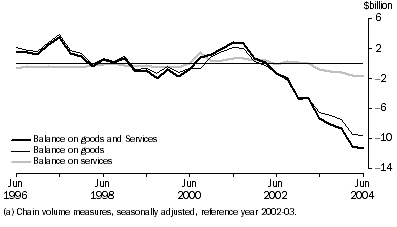
Goods Credits
The trend estimate of goods credits rose $1,481m (5%) to $28,974m in the June quarter 2004. Seasonally adjusted, goods credits were $30,088m, up $3,258m (12%) on the March quarter 2004, driven by increases in exports of non-rural and rural goods.
Rural goods (seasonally adjusted, current prices) rose $992m (16%) to $7,264m, with volumes up 13% and prices up 3%. The largest increases were in other rural goods, up $360m (14%), with volumes up 9% and prices up 4%, cereal grains and cereal preparations, up $259m (18%), with volumes up 12% and prices up 5%, and wool and sheepskins, up $215m (33%), mainly due to increased volumes.
Non-rural goods (seasonally adjusted, current prices) rose $2,362m (13%) to $20,932m, mainly due to price increases. The largest increases were in coal, coke and briquettes, up $883m (36%), with volumes up 5% and prices up 29%, metal ores and minerals, up $459m (13%), with volumes steady and prices up 13%, and in metals (excluding non-monetary gold), up $317m (17%), with volumes up 4% and prices up 13%.
Other goods (seasonally adjusted, current prices) recorded a decrease, down $96m (5%), driven by a fall in goods for processing.
General Merchandise Credits(a)
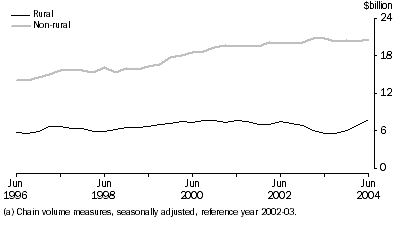
Goods Debits
The trend estimate of goods debits rose $1,297m (4%) to $34,783m in the June quarter 2004. In seasonally adjusted current price terms, goods debits rose $2,326m (7%) to $35,572m.
Consumption goods imports (seasonally adjusted, current prices) rose $618m (6%) to $11,527m, with a rise in volumes of 4% and a rise in prices of 1%. This increase was driven by textiles, clothing and footwear, up $240m (20%), with volumes up 17% and prices up 3%, food and beverages, mainly for consumption, up $139m (11%), driven by an increase in volumes of 10%, and consumption goods, n.e.s., up $126m (4%) with volumes up 1% and prices up 2%. Partly offsetting these increases was a fall in non-industrial transport equipment, down $30m (1%), with volumes down 1% and prices steady.
Capital goods imports (seasonally adjusted, current prices) rose $718m (9%) to $8,627m, with a rise in volumes of 6% and a rise in prices of 3%. The largest increases were in civil aircraft, up $331m (72%), with volumes up 63% and prices up 5%, machinery and industrial equipment, up $290m (11%), with volumes and prices both up 5%, and in ADP equipment, up $196m (16%), with volumes up 10% and prices up 5%. Offsetting these increases was a fall in imports of industrial transport equipment n.e.s., down $88m (8%), with volumes down 8%.
Intermediate and other goods (seasonally adjusted, current prices) rose $990m (7%) to $15,418m, driven by a rise in prices. The largest increases were in fuels and lubricants, up $472m (18%), with volumes down 1% and prices up 20%, processed industrial supplies n.e.s., up $260m (9%), with volumes up 3% and prices up 6%, and in other parts for capital goods, up $170m (8%), with volumes up 5% and prices up 3%. Offsetting these increases were falls in non-monetary gold, down $119m (48%), with volumes down 49% and prices up 3%, and other merchandise goods, down $105m (29%) with volumes down 32% and prices up 4%.
General Merchandise Debits(a)
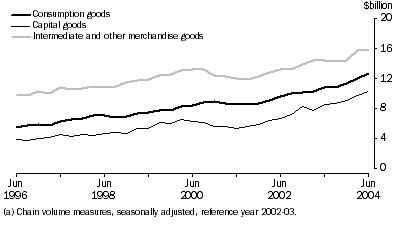
Services
The trend estimate of net services was a deficit of $234m, an increase of $178m on the March quarter 2004 deficit of $56m. In seasonally adjusted terms, net services recorded a deficit of $490m, a turnaround of $591m on the surplus of $101m for the March quarter 2004.
Services credits, in seasonally adjusted terms at current prices, fell $238m (3%) to $8,452m, mainly due to a decrease in volumes. Services debits, in seasonally adjusted terms at current prices, rose $353m (4%) to $8,942m, with volumes down 1% and prices up 5%. The largest fall in services credits was in travel services. The largest increase in services debits was in freight transportation services, largely due to increased freight prices.
Implicit Price Deflator
In seasonally adjusted terms, the implicit price deflator (IPD) for total goods and services credits rose 6.5%. In original terms, it rose by 6.2%. The chain Laspeyres price index for goods and services credits rose 6.9%, indicating that the compositional effects had a downward influence on the movement in the IPD. The IPD for goods credits rose 8.5% and the IPD for services credits rose 0.3%.
The total goods and services debits IPD rose 4.3% in seasonally adjusted terms. In original terms, it rose by 4.0%. The chain Laspeyres price index for debits rose 4.4%.
IMPLICIT PRICE DEFLATOR(a)
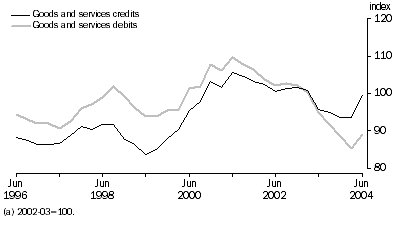
Relationship to IPI and EPI
Both the goods export IPD (in original terms) and the chain Laspeyres price index for goods exports rose 8.8%. The exports price index (EPI) rose 8.4% during the June quarter 2004.
During the June quarter 2004, the goods imports IPD (in original terms) rose 4.0% and the chain Laspeyres price index for goods imports rose 4.4%. The import price index (IPI) rose 4.1%.
Terms of trade
Australia's seasonally adjusted terms of trade rose 2.1% to 112.0, with an increase of 6.5% in the IPD for goods and services credits and a 4.3% increase in the goods and services debits IPD. The trend estimate of the terms of trade increased 2.6% to 112.0.
Income
The trend estimate of the net income deficit rose $75m (1%) to $6,031m.
In seasonally adjusted terms, the net income deficit rose $281m (5%) to $6,019m. Income credits rose $97m (2%) to $4,131m and income debits rose $378m (4%) to $10,150m.
In original terms, income credits rose $163m (4%) to $4,176m and income debits rose $110m (1%) to $10,149m.
Net Income
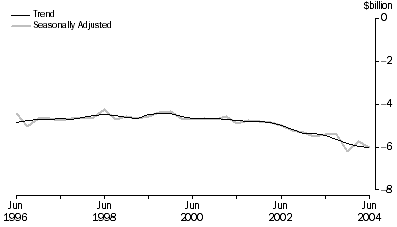
Current Transfers
In seasonally adjusted terms, net current transfers was a surplus of $26m, a turnaround of $62m on the $36m deficit recorded in the March quarter 2004. Current transfer credits fell $6m (1%) and debits fell $68m (6%).
CAPITAL AND FINANCIAL ACCOUNT
Capital Account
In original terms, the capital account surplus was $264m, up $6m on the March quarter 2004 surplus. Capital trasfer credits fell $26m (4%) to $636m, while capital transfer debits fell $38m (10%) to $351m.
Financial Account
In original terms, the balance on financial account recorded a net inflow of $11.8b, with a $13.4b inflow of debt and a $1.6b outflow of equity.
Direct investment in Australia recorded an inflow of $1.1b in the June quarter 2004, a turnaround of $1.3b on the March quarter outflow of $0.2b. Australia's direct investment abroad recorded an outflow of $2.5b, down from the previous quarter's outflow of $3.9b. This was the fourteenth consecutive quarterly outflow, bringing the total outflow on Australia's direct investment abroad to $65.4b since the March quarter 2001.
Portfolio investment recorded a net inflow of $19.2b, up $2.7b from the net inflow of $16.5b recorded in the March quarter 2004. Large debt security issues were made to re-finance maturing short term debt and loans, and to replace domestic issues with offshore issues to take advantage of interest rate differentials.
Other investment recorded a net outflow of $6.5b, up $6.4b on the small net outflow recorded in the March quarter 2004.
Reserve assets recorded a net inflow of $0.9b, a turnaround of $3.0b on the previous quarter's outflow of $2.1b, due to a decrease in foreign exchange reserves.
INTERNATIONAL INVESTMENT POSITION
INTERNATIONAL INVESTMENT
Australia's net international investment position at 30 June 2004 was a net foreign liability of $501.1b, up $11.8b (2.4%) on 31 March 2004. The increase consisted of:
- net transactions of $11.8b;
- price changes of $6.9b;
- exchange rate changes of -$3.7b; and
- other adjustments of -$3.1b.
During the June quarter 2004, the level of net debt liabilities rose $17.8b (4.7%) to $393.5b. New debt raisings of $13.4b and exchange rate changes of $10.4b were major contributors to this increase, offset by price changes and other changes of -$6.0b.
During the June quarter 2004, the level of net equity liabilities fell $5.9b (5.2%) to $107.7b, reflecting exchange rate changes of -$14.2b, transactions of -$1.6b, other changes of -$0.4b, offset by price changes of $10.2b.
FINANCIAL YEAR: 2003-2004 SITUATION
BALANCE OF PAYMENTS
In original terms, the balance on current account for 2003-04 was a deficit of $47.4b, a $7.1b (18%) increase on the deficit of $40.3b recorded for 2002-03. The balance on goods and services deficit of $24.1b was an increase of $5.5b (29%) on the deficit of $18.6b recorded in 2002-03. Goods exports decreased $6.8b (6%) (due largely to a decrease in prices) while goods imports decreased $1.4b (1%) (composed of a 12% increase in volumes and a 12% decrease in prices).
The 2003-04 services deficit of $0.4b was an increase of $0.1b (27%) on the deficit of $0.3b in 2002-03.
The 2003-04 net income deficit rose $1.8b (9%), with an increase in income credits of $0.5b (3%) and an increase in income debits of $2.4b (6%).
The balance on financial account recorded a net inflow of $47.1b, with a net inflow on debt of $50.0b and a net outflow on equity of $3.0b. This result was up $6.9b on the net inflow recorded for the previous year as a result of:
- a turnaround of $24.6b to a net outflow on direct investment;
- a rise of $57.5b in the net inflow on portfolio investment;
- a turnaround of $27.4b to a net outflow on other investment;
- a turnaround of $0.9b to a net inflow on financial derivatives; and
- a fall of $0.5b in the net outflow on reserve assets.
For 2003-04, the ratio of Australia's current account deficit to GDP, using the latest available GDP estimate (for the year ended March 2004), was 6.0%, compared with 5.3% for the previous year.
INTERNATIONAL INVESTMENT POSITION
Australia's net international investment position as at 30 June 2004 was a net foreign liability of $501.1b. This was up $50.4b (11.2%) on the position a year earlier as a result of:
- net transactions of $47.1b;
- price changes of $10.7b;
- exchange rate changes of -$5.0b; and
- other adjustments of -$2.4b.
During 2003-04, the level of net equity liabilities rose to $107.7b, up $14.1b (15.0%) on the previous year, with transactions of -$3.0b and other changes of -$1.1b outweighed by price changes of $17.6b and exchange rate changes of $0.5b.
Net foreign debt rose to $393.5b, up $36.3b (10.2%) on the previous year, with transactions of $50.0b, offset by price changes -$6.9b, exchange rate changes of -$5.5b and other adjustments of -$1.3b.
At 30 June 2004, the ratio of Australia's net international position to GDP using the latest available GDP figure (for the year ended March 2004) was 63.1%. This compares with 59.8% one year ago and 52.8% one decade ago.
 Print Page
Print Page
 Print All
Print All